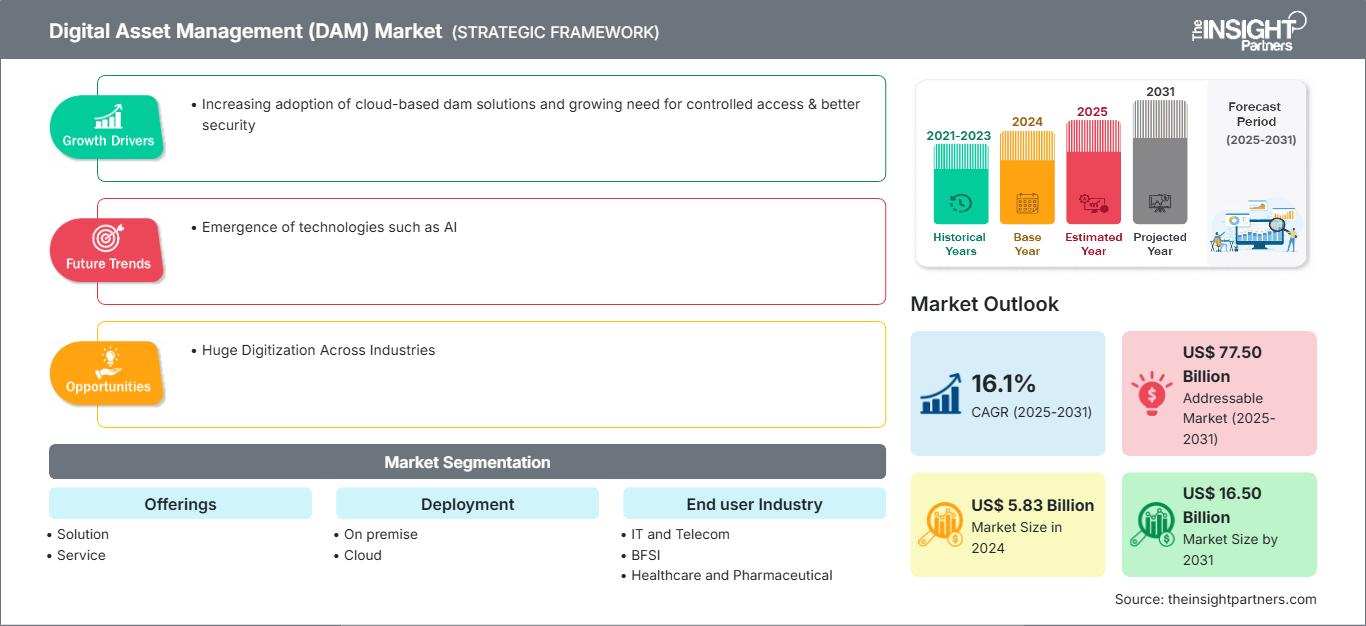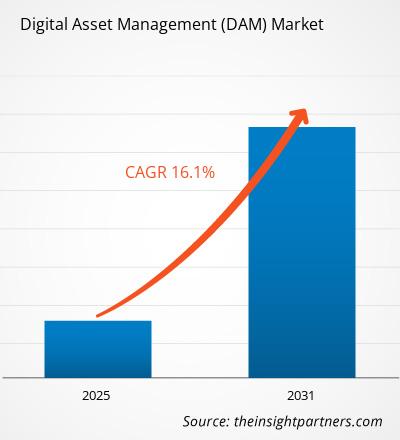预计到2031年,数字资产管理市场规模将达到24936.7亿美元。该市场在2025年至2031年期间的复合年增长率预计将达到18.0%。人工智能等技术的出现很可能仍将是该市场的一个关键趋势。
数字资产管理(DAM)市场分析
过去几年,由于企业数字化程度的提高以及对高效内容管理解决方案的巨大需求,数字资产管理 (DAM) 市场经历了强劲增长。数字内容的不断增加、对开源 DAM 的巨大需求以及数据编排技术的进步等因素,都是推动 DAM 市场增长的主要动力。对技术进步的日益重视以及云端 DAM 解决方案的广泛应用,也为 DAM 市场带来了丰厚的增长机遇。此外,机器学习和人工智能在 DAM 领域的应用,以及数据分析和洞察在数字资产管理中日益重要的地位,预计也将推动 DAM 市场在预测期内持续增长。
数字资产管理 (DAM) 市场概览
数字资产管理 (DAM) 系统存储、组织、检索、编目和分发数字资产,例如视频、图像、文档和其他多媒体内容。DAM 系统通常提供用于管理数字资产生命周期的工具,包括版本控制、创建、审批和分发。DAM 的主要目标是提供一个集中式的数字资产存储库,帮助团队访问和查找所需的资产,并确保这些资产在不同平台和渠道上得到一致且恰当的使用。此外,DAM 还可以增强协作、提高工作效率和资产重用率,同时减少冗余存储和资产重复成本。从小型企业到大型企业,各种规模的组织都可以使用 DAM 系统。DAM 系统可以根据众多行业的需求进行定制,包括媒体和娱乐、政府、教育、营销等。
根据您的需求定制此报告
您可以免费获得任何报告的定制服务,包括本报告的部分内容、国家/地区层面的分析、Excel 数据包,以及面向初创企业和高校的优惠折扣。
数字资产管理 (DAM) 市场:战略洞察

- 获取本报告的主要市场趋势。这份免费样品将包含数据分析,内容涵盖市场趋势、估算和预测等。
数字资产管理(DAM)市场驱动因素和机遇
云端数字资产管理解决方案的日益普及将有利于市场发展
推动数字资产管理行业发展的主要动力之一是云端数字资产管理解决方案的日益普及。与传统的本地部署解决方案相比,云端数字资产管理解决方案具有诸多优势,包括灵活性、可扩展性和易用性。借助云端数字资产管理 (DAM),企业可以将数字资产集中安全地存储和管理,并可随时随地访问。这使得团队能够更轻松地共享资产和协作,不受设备或位置的限制。此外,云端 DAM 解决方案具有更强的可扩展性,允许企业随着数字资产库的增长而扩展存储容量。这有助于企业避免传统本地部署解决方案的高昂前期成本,后者需要大量的硬件和基础设施投资。
此外,基于云的数字资产管理 (DAM) 解决方案极其灵活,提供一系列定制选项,以满足不同行业和组织的特定需求。它们还提供机器学习和人工智能等高级功能,可以帮助组织自动化管理数字资产的诸多任务,例如分类和标记。此外,基于云的数字资产管理解决方案的日益普及推动了数字资产管理行业的增长和发展。它使组织能够优化工作流程并提升数字资产管理水平。
各行各业的数字化转型
受新冠疫情影响,各行各业都经历了向远程办公的巨大转变。居家办公的趋势凸显了企业数字化转型的重要性。居家办公的员工需要访问数字资产,这导致对数字资产管理解决方案的需求激增。企业依靠数字资产管理解决方案来应对因营销趋势转变而产生的日益增长的数字资产。
数字资产管理 (DAM) 市场报告细分分析
构成数字资产管理 (DAM) 市场分析的关键细分市场包括产品/服务、部署、业务功能和最终用户行业。
- 根据产品类型,数字资产管理(DAM)市场可分为软件和服务两大类。2023年,软件市场份额更大。
- 根据类型,数字资产管理 (DAM) 市场分为云端部署和本地部署。2023 年,云端部署占据了更大的市场份额。
- 按业务职能划分,市场可分为人力资源、销售与市场营销、信息技术及其他。2023年,信息技术细分市场占据最大的市场份额。
- 从终端用户行业来看,市场可细分为IT和电信、银行、金融服务和保险(BFSI)、医疗保健和制药、制造业、政府及其他行业。预计在预测期内,IT和电信细分市场将以最高的复合年增长率增长。
数字资产管理 (DAM) 市场份额地域分析
数字资产管理 (DAM) 市场报告的地理范围主要分为五个区域:北美、亚太、欧洲、中东和非洲以及南美和中美洲。
预计亚太地区在预测期内将实现最快增长。由于语言、内容和其他方面的复杂要求,印度被认为是媒体和娱乐供应商管理起来颇具挑战性的市场。因此,数字资产管理被广泛应用以应对这些复杂性。在中国,企业数字化转型已成为一种趋势。2021年10月,一位毕业于哈佛大学的设计师凭借其内容营销平台打造了一家独角兽企业,投资者们认为企业软件是中国科技行业的下一个重大机遇。
数字资产管理 (DAM) 市场区域洞察
The Insight Partners 的分析师对预测期内影响数字资产管理 (DAM) 市场的区域趋势和因素进行了详尽的阐述。本节还探讨了北美、欧洲、亚太地区、中东和非洲以及南美和中美洲的数字资产管理 (DAM) 市场细分和地域分布。
数字资产管理 (DAM) 市场报告范围
| 报告属性 | 细节 |
|---|---|
| 2024年市场规模 | XX亿美元 |
| 到2031年市场规模 | 24936.7亿美元 |
| 全球复合年增长率(2025-2031年) | 18.0% |
| 史料 | 2021-2023 |
| 预测期 | 2025-2031 |
| 涵盖部分 | 按供奉
|
| 覆盖地区和国家 | 北美
|
| 市场领导者和主要公司简介 |
|
数字资产管理(DAM)市场参与者密度:了解其对业务动态的影响
数字资产管理 (DAM) 市场正快速增长,这主要得益于终端用户需求的不断增长,而终端用户需求的增长又源于消费者偏好的转变、技术的进步以及消费者对产品优势认知的提高。随着需求的增长,企业不断拓展产品和服务,持续创新以满足消费者需求,并把握新兴趋势,这些都进一步推动了市场增长。

- 获取数字资产管理 (DAM) 市场主要参与者概览
数字资产管理(DAM)市场新闻及最新动态
数字资产管理 (DAM) 市场评估是通过收集定性和定量数据,结合一手和二手研究成果进行的,这些研究包括重要的企业出版物、协会数据和数据库。以下列出了数字资产管理 (DAM) 市场的一些发展趋势:
- ABB推出面向仪器仪表的数字化资产性能管理平台。ABB Ability™ SmartMaster资产性能管理平台能够采集、分析和验证来自现场设备的诊断数据,从而帮助提高水处理、污水处理、化工、石油天然气等行业的运营效率。(来源:ABB,新闻稿,2023年11月)
- 数字体验公司Acquia宣布对其数字资产管理平台Acquia DAM(Widen)进行升级,其中包括一款功能强大的AI聊天机器人,旨在辅助创意工作流程。(来源:Acquia,新闻稿,2023年5月)
数字资产管理 (DAM) 市场报告涵盖范围和成果
《数字资产管理(DAM)市场规模及预测(2021-2031)》报告对以下领域进行了详细的市场分析:
- 数字资产管理 (DAM) 市场规模及预测,涵盖全球、区域和国家层面的所有关键细分市场。
- 数字资产管理 (DAM) 市场趋势,以及市场动态,例如驱动因素、制约因素和关键机遇。
- 详细的PEST/波特五力模型和SWOT分析
- 数字资产管理(DAM)市场分析,涵盖关键市场趋势、全球和区域框架、主要参与者、法规以及近期市场发展动态。
- 数字资产管理 (DAM) 市场的行业格局和竞争分析,包括市场集中度、热力图分析、主要参与者和最新发展动态
- 公司详细概况
- 历史分析(2 年)、基准年、预测(7 年)及复合年增长率
- PEST和SWOT分析
- 市场规模、价值/数量 - 全球、区域、国家
- 行业和竞争格局
- Excel 数据集
近期报告
客户评价
购买理由
- 明智的决策
- 了解市场动态
- 竞争分析
- 客户洞察
- 市场预测
- 风险规避
- 战略规划
- 投资论证
- 识别新兴市场
- 优化营销策略
- 提升运营效率
- 顺应监管趋势




















 获取免费样品 - 数字资产管理(DAM)市场
获取免费样品 - 数字资产管理(DAM)市场